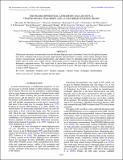THE PHASES DIFFERENTIAL ASTROMETRY DATA ARCHIVE. II. UPDATED BINARY STAR ORBITS AND A LONG PERIOD ECLIPSING BINARY
Author(s)
Muterspaugh, Matthew W.; Hartkopf, William I.; Lane, Benjamin F.; O’Connell, J.; Williamson, M.; Kulkarni, S. R.; Konacki, Maciej; Burke, Bernard F.; Colavita, M. M.; Shao, M.; Wiktorowicz, Sloane J.; ... Show more Show less
DownloadMuterspaugh-2010-THE PHASES DIFFERENT.pdf (229.4Kb)
PUBLISHER_POLICY
Publisher Policy
Article is made available in accordance with the publisher's policy and may be subject to US copyright law. Please refer to the publisher's site for terms of use.
Terms of use
Metadata
Show full item recordAbstract
Differential astrometry measurements from the Palomar High-precision Astrometric Search for Exoplanet Systems have been combined with lower precision single-aperture measurements covering a much longer timespan (from eyepiece measurements, speckle interferometry, and adaptive optics) to determine improved visual orbits for 20 binary stars. In some cases, radial velocity observations exist to constrain the full three-dimensional orbit and determine component masses. The visual orbit of one of these binaries—α Com (HD 114378)—shows that the system is likely to have eclipses, despite its very long period of 26 years. The next eclipse is predicted to be within a week of 2015 January 24.
Date issued
2010-10Department
Massachusetts Institute of Technology. Department of Physics; MIT Kavli Institute for Astrophysics and Space ResearchJournal
The Astronomical Journal
Publisher
IOP Publishing
Citation
Muterspaugh, Matthew W., William I. Hartkopf, Benjamin F. Lane, J. O’Connell, M. Williamson, S. R. Kulkarni, Maciej Konacki, et al. “THE PHASES DIFFERENTIAL ASTROMETRY DATA ARCHIVE. II. UPDATED BINARY STAR ORBITS AND A LONG PERIOD ECLIPSING BINARY.” The Astronomical Journal 140, no. 6 (October 20, 2010): 1623–1630. © 2010 The American Astronomical Society
Version: Final published version
ISSN
0004-6256
1538-3881